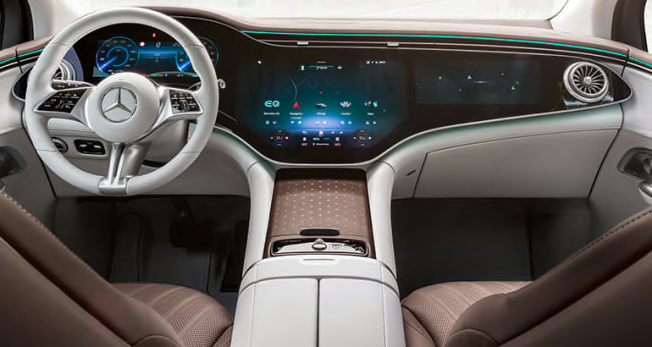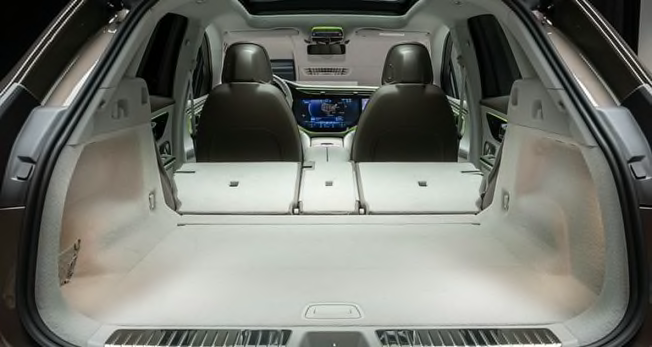Preview: Tech-Filled 2023 Mercedes-Benz EQE SUV Charges Ahead
Convenience and safety features from the EQS flagship migrate down to this midsized electric SUV
By Jeff S. Bartlett
Mercedes-Benz is on a tear, introducing electric models at a rapid pace that parallel its conventional lineup. The latest production model is the EQE SUV, an electric alternative to the midsized GLE SUV. Similarly, there is an EQE sedan to complement the E-Class sedan.
Mercedes launched this initiative with the EQS sedan, the electric companion to the ultra-luxury S-Class sedan. We just finished testing that flagship model, finding it to be a true technological tour de force. Following a long-established tradition, much of its concepts and tech will move down the product line, as exhibited by the EQE SUV.
For example, the futuristic EQE SUV cabin houses an MBUX Hyperscreen—a series of three screens that span the width of the dashboard, providing the driver and passenger with a wide range of information and interactivity. Ambient lighting throughout furthers the sci-fi flair.
There are other, less obvious features that distinguish the EQE, such as the optional rear axle steering that can help the long-wheelbase SUV maneuver like a smaller vehicle. Another hidden element is the brand’s commitment to sustainability. Beyond Mercedes’ strategy to provide an electric choice for every step of its model lineup, the automaker has committed to numerous environmental goals, such as CO₂-neutral manufacturing, local sourcing for batteries, and using recycled materials in the vehicle.
Sharing the premium electric platform, as it is known, with the other preceding models, the EQE SUV will be offered initially in three configurations: EQE 350 with rear-wheel drive, EQE 350 with all-wheel drive, and EQE 500 with all-wheel drive. A higher-performance AMG version will be offered in 2024.
The EQE SUV is built in Tuscaloosa, Ala.. This is the same facility where the Mercedes-Benz GLE SUV, GLS SUV, GLE Coupe, and the Mercedes-Maybach GLS are manufactured.
What it competes with: Audi E-Tron, BMW iX, Cadillac Lyriq, Jaguar I-Pace, Polestar 3, Tesla Model X
What it looks like: A portly Honda HR-V
Powertrains: 288-hp, single motor with rear-wheel drive; 288-hp, single motor with all-wheel drive; or 536-hp, dual motor with all-wheel drive
Price: $77,900-$95,450
On sale: Early 2023
CR's Take
The premium, midsized electric SUV segment is getting crowded, as every major prestige brand launches new models and some start-ups join the fray, like Fisker, Polestar, and Rivian. It seems like the center of EV action is happening at the higher end of the market, but as the EQE SUV shows, much of the innovative technology showcased on top-shelf models will move its way down over time. Really.
Here, we see an SUV that overflows with features and capabilities, with the most eye-catching gear being optional, of course. Ultimately, for models like the EQE SUV, it is important to see how complex the vehicle is to the user. By definition, luxury models should remove stress, but there is a clear risk that content overload can lead to confusing controls and complicated features that go unused.
The power, packaging, and safety features all sound appealing. We’ll find out whether it lives up to the promise when we buy one to test.
Outside
The exterior is smooth, with rather simple lines, akin to other recent Mercedes-Benz models. Visually connecting it to other EQ models is the large, black plastic grille and aerodynamic, rather bulbous design. To some eyes, the styling might be reminiscent of the redesigned Honda HR-V, itself a tastefully rendered, albeit bland, SUV.
Proportionally, it is similar to other Mercedes EQ models with short overhangs and an aerodynamically raked windshield. The A-pillars are pushed far in front of the driver, which we found to hinder visibility slightly in our EQS when combined with the tall dashboard. Like many other EVs, it uses retractable door handles to help cheat the wind. We’ve found in general that these are a fun show-off item, but they can be frustrating to use.
The rear has a horizontal, wrap-around lighting design. The hatch is sloped, with an integrated roof spoiler. This shape will limit the ability to carry tall cargo in the back.

The EQE uses wheels sized from 19 to 21 inches. This example shows the optional running boards.
Photo: Mercedes-Benz
Inside
The showroom “wow” feature is clearly the dazzling dash. Although it comprises three screens (instrument panel, center infotainment, and passenger screen), the MBUX Hyperscreen presents as a single, massive OLED display. We found that a similar setup in the EQS sedan feels like technology overload, making it a challenge to learn how to access many key features. Adding to the wild appearance is ambient lighting throughout, which can be customized among 64 colors. A panoramic roof allows natural light to further brighten the interior.
The standard stereo is a premium Burmester system with Dolby Atmos, a technology designed to provide a 360-degree listening experience. And it comes with wireless phone charging.
This is a two-row SUV: All versions seat five occupants. Base upholstery is MB-Tex simulated leather, with the EQE 500 boasting true leather.

If you look closely at the interior photo, you can see the screens behind the massive, shared pane of glass.
Photo: Mercedes-Benz
What Drives It
The EQE SUV comes in three configurations: EQE 350, EQE 350 4Matic, and EQE 500 4Matic. An AMG version will arrive in 2024. All share a 90.6-kWh lithium-ion battery, a 9.6-kW onboard charger, and a maximum DC Fast Charge rate of 170 kW. Mercedes estimates charge times to be 9.5 hours on a 240-volt charge unit (from 10 to 100 percent state of charge) and 32 minutes on a DC Fast Charger (from 10 to 80 percent state of charge). It is worth noting that most drivers don’t top off when using public chargers, hence the different figures for state of charge.
- EQE 350: 288-hp, single motor with rear-wheel drive
- EQE 350 4Matic: 288-hp, single motor with all-wheel drive
- EQE 500 4Matic: 536-hp, dual motor with all-wheel drive
The driver can select Eco, Comfort, Sport, and Individual modes to configure the SUV’s performance to their tastes. 4Matic models add an Off-road mode.
To maximize the regenerative brakes’ ability to transfer energy as electricity, the EQE allows single-pedal driving. Lift the accelerator and the vehicle will slow as if braking, while capturing that energy.
An adaptive air suspension is optional.
Mercedes has not released U.S. range estimates.

Like many sporty-looking SUVs, the rear cargo space in the EQE SUV is compromised by the sloping hatch.
Photo: Mercedes-Benz
Safety and Driver Assistance Systems
The EQE SUV comes standard with a basic suite of active safety features, such as automatic emergency braking, lane keeping assistance, and blind spot warning.
Beyond that, there is an extensive roster of advanced features that are available. This includes:
- Active cruise control with lane centering assist grants the EQE the ability to negotiate stop-and-go traffic up to 35 mph.
- Driver monitoring that can determine whether the driver is inattentive or unresponsive and cause the car to come to a stop.
- Sign recognition that can read speed limit and traffic signs.
- Among the “Pre-Safe” features that prepare the vehicle for an imminent collision, such as tightening seat belts and turning on hazard lights as a car approaches from behind, there is an interesting feature that emits a short sound to trigger the ears into a protective reaction to prevent hearing loss during an impact.
- Another bit of clever engineering is the Pre-Safe Impulse Side feature that moves the driver or front passenger up to 2.75 inches away from a side impact by using the side airbags.
Consumer Reports is an independent, nonprofit organization that works side by side with consumers to create a fairer, safer, and healthier world. CR does not endorse products or services, and does not accept advertising. Copyright © 2023, Consumer Reports, Inc.
